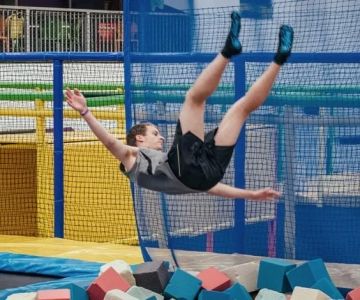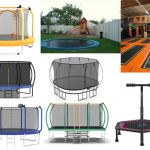- How-to-bounce-mindfully-for-stress-relief
- Understanding-the-connection-between-bouncing-and-stress-relief
- Practical-steps-for-mindful-bouncing-techniques
- Real-life-examples-and-benefits-of-mindful-bouncing
- Choosing-the-right-equipment-and-resources
1. How to Bounce Mindfully for Stress Relief
Bouncing mindfully is a simple yet powerful practice that combines physical movement with focused awareness to help alleviate stress. Rather than jumping mindlessly, mindful bouncing encourages you to pay attention to your body’s sensations, breathing, and emotions while you move. This practice can be done on a trampoline, mini-trampoline, or even on soft ground, making it accessible and adaptable for many people seeking natural stress relief.
By integrating mindfulness into bouncing, you transform what might seem like just a fun activity into a therapeutic exercise that supports mental and physical wellbeing. The key is to stay present in the moment, observe how your body responds to each bounce, and use this awareness to release tension.
2. Understanding the Connection Between Bouncing and Stress Relief
2.1 Physical Benefits of Bouncing
Bouncing stimulates the lymphatic system, which helps detoxify the body and boost immune function. This gentle movement also improves circulation and releases endorphins—our natural “feel-good” hormones—leading to a reduction in stress hormones like cortisol.
2.2 Mental and Emotional Impact
Mindful bouncing engages your brain’s focus and calms the nervous system by shifting attention away from stressors. This rhythmic motion encourages relaxation and can act as a moving meditation, helping break the cycle of anxious thoughts. Through repetitive bouncing, your mind settles, providing clarity and emotional balance.
3. Practical Steps for Mindful Bouncing Techniques
3.1 Preparing for Mindful Bouncing
Begin by selecting a safe and comfortable place to bounce. It’s important to wear comfortable clothing and ensure the trampoline or bouncing surface is secure. Take a few deep breaths to center your attention before starting.
3.2 Engaging Your Senses
As you start bouncing, focus on the sensations in your feet as they lift and land, the gentle stretch in your muscles, and the rhythm of your breath. Notice the subtle shifts in balance and the flow of energy through your body. This sensory awareness anchors you in the present moment.
3.3 Breath and Movement Synchronization
Try syncing your breathing with your bouncing rhythm—inhale deeply as you rise, exhale slowly as you land. This conscious breathing enhances relaxation and deepens the mindfulness experience.
3.4 Gradually Increasing Duration and Intensity
Start with short sessions of 5 to 10 minutes, gradually extending the time as your body and mind adjust. Maintain a gentle bouncing pace that feels natural and avoid pushing yourself too hard.
4. Real-Life Examples and Benefits of Mindful Bouncing
4.1 A Personal Story of Stress Relief
Jessica, a marketing professional, shared how mindful bouncing became her go-to stress relief practice during a high-pressure project. She began using a mini-trampoline at home for 10 minutes daily, focusing on breath and movement. Within weeks, she noticed significant decreases in anxiety and improved focus, making her daily workload more manageable.
4.2 Popular Cases and Trends
Mindful bouncing has gained traction as a wellness trend in urban wellness communities, especially among those seeking low-impact stress relief alternatives. Wellness influencers often highlight trampoline exercises as a joyful and effective way to maintain mental health, encouraging followers to adopt mindful movement as part of their routines.
4.3 Scientific Backing
Studies on rebounding exercise indicate improvements in mood, balance, and lymphatic function. When combined with mindfulness, these effects are amplified, showing promise for stress management without relying on medication or complicated interventions.
5. Choosing the Right Equipment and Resources
5.1 Selecting the Best Trampoline for Mindful Bouncing
Not all trampolines are created equal. For mindful bouncing focused on stress relief, look for models that offer stability, appropriate size, and cushioning to ensure comfort and safety. Quality construction reduces injury risk and supports longer practice sessions.
5.2 Additional Tools and Supports
Consider accessories such as handrails for beginners or balance trainers to enhance stability. Comfortable footwear or going barefoot depending on the surface can also improve sensory feedback during mindful bouncing.
5.3 Where to Find Reliable Products
For those ready to start their mindful bouncing journey, Trampoline Zone offers a curated selection of trampolines and related equipment tailored to support mindful stress relief. Their expert advice and product variety help users find exactly what fits their needs and space, ensuring a safe and enjoyable experience.







 Sky Zone Trampoline Park4.0 (541 reviews)
Sky Zone Trampoline Park4.0 (541 reviews) Launch Family Entertainment Park Norwood4.0 (730 reviews)
Launch Family Entertainment Park Norwood4.0 (730 reviews) Southern Ohio Gymnastics Academy ( SOGA )4.0 (40 reviews)
Southern Ohio Gymnastics Academy ( SOGA )4.0 (40 reviews) Jumpify2.0 (15 reviews)
Jumpify2.0 (15 reviews) Jump! Gymnastics4.0 (102 reviews)
Jump! Gymnastics4.0 (102 reviews) Sky Zone Trampoline Park4.0 (248 reviews)
Sky Zone Trampoline Park4.0 (248 reviews) Are Trampoline Parks Safe for Kids? Essential Guide for U.S. Parents
Are Trampoline Parks Safe for Kids? Essential Guide for U.S. Parents How Often Should You Replace Trampoline Springs? Tips for Proper Maintenance
How Often Should You Replace Trampoline Springs? Tips for Proper Maintenance How Much Is a Trampoline? A Detailed Guide to Trampoline Costs and Buying Tips
How Much Is a Trampoline? A Detailed Guide to Trampoline Costs and Buying Tips Bounce Techniques for Stronger Legs: Effective Exercises and Tips
Bounce Techniques for Stronger Legs: Effective Exercises and Tips Essential Music Gear for Trampoline Dance: Complete Guide
Essential Music Gear for Trampoline Dance: Complete Guide Fun STEM Experiments Using Trampolines to Spark Curiosity and Learning
Fun STEM Experiments Using Trampolines to Spark Curiosity and Learning